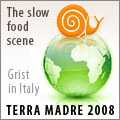
Turin, Italy — Yesterday I left off at the Presidia section of the Salone del Gusto, having met up with my friend the fermentation scholar and teacher Sandor Katz, and his friend the food scholar Jeffrey Roberts, author of The Atlas of American Artisinal Cheese.
By that point, I was overwhelmed by the variety on display and unsure what to make of it all. Sandor’s enthusiasm changed all that. “We’re sampling some English pear cider,” he informed me. “Only she won’t let us call it that,” he whispered, glancing briefly in the direction of a formidable elderly British woman. “She calls it something different.”
She called it “perry” — and it was delicious: dry, slightly sharp, ever so slightly carbonated. Turned out it was from some sort of heirloom pear variety from the British countryside, in danger of going extinct if people stop making cider — I mean, perry — from it.
And that’s what the Presidia section was about. While the main part of the Salone del Gusto focused on prestigious Italian producers of well-established stuff — think Parmigiano-Reggiano and Prosciutto di Parma — the Presidia part focused on quirky products. And the producers hailed from all over the world, including, but not limited to, Italy.
And it’s here where I think Slow Food has done essential work — not just in terms of gastronomy, but also in terms of future sustainability.
Here’s a paradox of the modern food world: Italy, now universally hailed as a culinary nation par excellence, was until very recently largely a poor country. Indeed, the entire Mediterranean region — celebrated for its healthy and delicious cuisine — was riddled for centuries with a stunning lack of food.
Clifford A. Wright’s ironically titled A Mediterranean Feast documents the crushing poverty under which the great majority of Mediterraneans labored under for centuries. Under heavy population pressure and with few resources, Mediterranean peasants worked miracles in the field and in the kitchen to survive.
And in doing so, they created the diet now so widely admired. As we enter an era marked by population pressure and increasingly scarce resources, we may well have vital lessons to learn from these artisan peasants. Slow Food deserves great credit for fighting to preserve remaining traditions from this era.

I could detail any number after wandering the aisles of the Presidia section of the Salone del Gusto. My favorite one is a particular kind of goat salami produced in Italy’s far north, on the border with Switzerland. Farmers keep goats grazing on the hills of the area, from whose milk they make a pungent cheese. Usually, goat meat is only consumed from young animals. Yet when these particular goats become too old to give milk, they’re slaughtered and their legs are salt-cured into large salamis.
To slice them, the artisan maker nestles the fat end between his shoulder and chin, holding the skinny end in one hand, slicing with the other, holding the knife like a violin’s bow. The resulting salami is fantastic: rich, deep red, mineral-y, and surprisingly tender from such an old animal.
Learning such tricks — turning hillsides into delicious, nourishing cheeses and meats — will likely be critical as populations grow and resources deplete. Critical, and delicious too.
I haven’t just been eating and talking to cool old people. I’ve also been listening to speeches. More on that soon.

